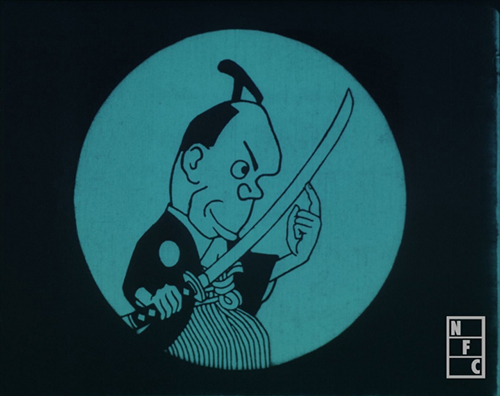A Trove of Early Japanese Animated Films Is Now Online
To celebrate the centennial of Japanese animation, the National Film Center of Japan recently uploaded over 60 films made between 1917 and 1941.
Still from “At the Border Checkpoint” (1930), animated by Noburo Ofuji
(all images courtesy National Film Center, National Museum of Modern Art, Tokyo)
The oldest extant Japanese animation tells the comical tale of a samurai who makes a bad purchase. Rediscovered in 2008 in an Osaka antique store, “The Dull Sword,” or “Namakura Gatana,” centers on its protagonist’s failed attempts to use his new, dull weapon, providing many humorous moments throughout its two-minute run (including a lot of goofy, rolling eyeballs). The short was produced in 1917 by anime pioneer Jun’ichi Kōuchi, and to celebrate its centennial, the National Film Center of Japan’s National Museum of Modern Art recently uploaded over 60 vintage, animated film classics on one website, all made between 1917 and 1941.
Cover of the script for “Where Did Dumpling Go?” (1937), animated by Noburo Ofuji
Although the platform is only in Japanese, it’s navigable by auto-translating its pages through Google. As for the animations themselves, many are silent, and many come with the convenient option of turning on English subtitles to understand any text. You can search through the collection by genre, including fable, historical drama, and propaganda film; by animation technique, such as cut-out and silhouette animation; and even by action, if you’re curious about how dancing, sleeping, eating, and flying were successfully realized with the limited technologies of the time.
Most of today’s viewers are likely familiar with Hayao Miyazaki, one of the founders of Studio Ghibli, which has churned out beloved animated films from Princess Mononoke to Howl’s Moving Castle. But less widely known are his forebears, who include Kōuchi, Noburō Ōfuji, and Sanae Yamamoto. The new film archive provides a handy primer on 10 pioneers of anime (all men) who directed the featured classics.
It’s all too easy to get lost in the collection, which meticulously catalogues every work, providing as much information as possible, from context to film projection speed. The narratives on their own are entertaining (see, for instance, Yamamoto’s 1936 film about war, featuring an army of frogs riding crickets and snails built like tanks), but what’s really impressive is the array of techniques employed to produce them, which are simple but incredibly effective. Yamamoto’s take on the tale of the tortoise and the hare relies on modest line drawings, while Ōfuji combines live action with animation in his playful 1926 story about tobacco and women. Then there’s his utterly bewildering “At the Border Checkpoint” (“Osekisho”) from 1930, a silent drama in which humans and animals made of cut paper move with fluidity and thrilling speed. Creatures such as bears, cats, and raccoons dance on screen, forming kaleidoscopic patterns until violent fighting breaks out, with plenty of beheadings and bludgeoning; chaos ensues — and then comes a burst of cherry blossoms to end it all.

Film director and animator Noburo Ofuji
Still from “Spring Comes to Ponsuke” (1934) (originally from Planet Film Archive)
Silhoutte artwork with colored cellophane for “The Phantom Ship” (1956), directed by Noburo Ofuji
https://hyperallergic.com/369024/a-trove-of-early-japanese-animated-films-is-now-online/




